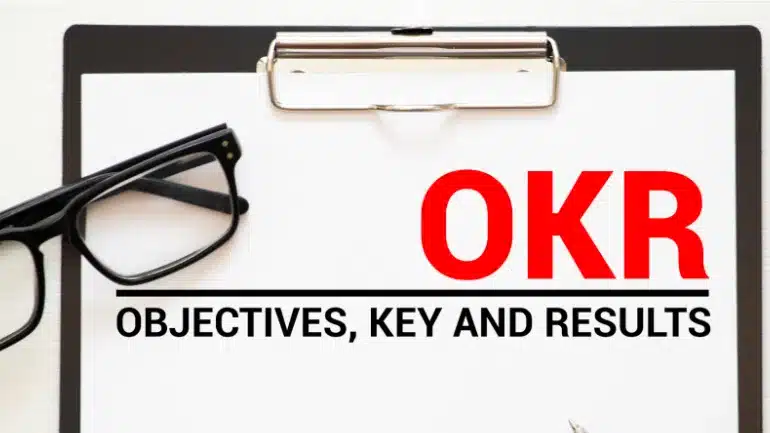OKR continues to assist leaders and organizations across the industries in achieving their most ambitious objectives. Still, occasionally, we find ourselves pondering, “Wait, what does that word mean?”
In this article, we will provide you with a glossary of phrases used frequently in the OKR world.
The OKR methodology has helped leaders and organizations all over the world achieve their most ambitious objectives. However, every now and again, we hear someone strike a term that perplexes us.
Considering that you’re up against industry professionals and global leaders in leading a high performing team, you might want to check out this glossary of OKR terms.

As a result, we decided to go back to the beginning: definitions. A glossary of meanings for terminology often used in the OKR realm can be found here.
Continue reading to learn more about OKR concepts and strategies for success.
OKR Glossary
A
Accountability
Accepting responsibility for one’s own conduct is known as accountability. It suggests a willingness to be open about one’s performance, allowing others to witness and criticize it.
Action Item
As you finish tasks on a to-do list, you check them off. To be clear, crossing items off a to-do list does not always imply that you are making progress toward your objectives. Objectives and key results are not the same as action items. Your OKRs should, in theory, inform your daily or weekly to-do lists. If an OKR isn’t on track, your to-do list should preferably adjust in speed or scope.
OKR Software – Used by 500+ Companies
Transform your managers into leaders through personalized coaching, bite-size learnings and make it super easy for them to have meaningful 1:1s, check-ins, and align goals(OKRs).
Align
Increasing the visibility of teams and bringing them together in support of common aims. Setting OKRs at different levels of an organization brings the company’s top priorities to the surface. This openness enhances the chances of success. Align is an OKR Superpower.
Aspirational OKRs
Aspirational OKRs are another name for Moonshot goals. It’s all about aiming high, as the name suggests. Depending on how ambitious the objective value is, Key Results might be regarded as committed or aspirational.
The idea is that if we organize ourselves around achieving 100% of an Aspirational OKR, we might only get to 70%. However, 70% of a big, audacious goal will get you much further than 10% of a mediocre goal!
B
Business Objectives
The organization’s overarching aims, which apply to all departments, teams, and personnel.

Bottom-up OKR
Any OKR that is created in response to a higher-level OKR in the organization. The ideal consequence is engagement and alignment when clear information and communication flows from the top layer of an organization to the entry-level and vice versa.
Business as usual
An organization’s or team’s day-to-day or routine operations and activities. “Business as usual” is often abbreviated as “BAU.”
Business Objectives
The organization’s overarching aims, apply to all departments, teams, and personnel.
C
Cascading Objectives
Cascading objectives are a hierarchical framework for organising a company’s objectives. Strategic goals are created at the highest level, or executive level, and then cascade down through the rest of the business to drive team and individual goals.
Cadence
The pace at which an organization’s OKR cycle is set Setting OKRs, checking in, rating OKRs, and reflecting are all steps in an OKR cycle. An OKR cycle can be configured to an annual, quarterly, or monthly rhythm to fit the needs of your team, depending on the culture and setting of your firm.
OKR Software – Used by 500+ Companies
Transform your managers into leaders through personalized coaching, bite-size learnings and make it super easy for them to have meaningful 1:1s, check-ins, and align goals(OKRs).
CFRs:
This acronym stands for Conversation, Feedback, and Recognition, and it refers to all of the interactions that give OKRs a human voice and ensure that they don’t exist in isolation.
CFRs occur throughout the OKR cycle, including in one-on-one meetings: in person, over video chat, or even in regular email updates. Transparency, accountability, empowerment, and teamwork are all catalyzed by CFRs at all levels of an organization.

Child OKR:
After cascading an OKR, it nested beneath a parent OKR.
Collective commitment:
A common goal that everyone in the company believes is worthwhile to pursue and actively works toward. Trust and honesty are required for a group commitment. Everyone engaged must be aware of the objective and their role in attaining it.
Confidence Vote:
A vote in which each team member expresses their confidence in their team’s ability to achieve a specific goal. Confidence votes prevent groupthink and guarantee that everyone is on the same page when it comes to a certain OKR.

Continuous Performance Management:
In contrast to traditional performance management, which is often a once-a-year activity linked to annual appraisals, continuous performance management is defined as an ongoing process that allows managers and employees to exchange feedback on a regular basis to achieve near-term business objectives.
Committed OKR:
OKRs fall into this category, with the other two being Aspirational and Learning. Unlike an aspirational OKR, these OKRs are goals that everyone agrees must be met. We wouldn’t be able to succeed without them. We’ll put everything we have into making this OKR a success by the conclusion of our 90 days.
Commit OKR:
Holding oneself responsible for achieving a goal.

Culture:
Doerr describes culture as “the live embodiment of an organization’s most cherished values and ideas” in “Measure What Matters.” Transparency and accountability are the foundations of a healthy organizational culture.
Although the word “business culture” is a misty idea, most culture experts can agree on the fundamentals of a definition. In a nutshell, company culture is defined as an organization’s common set of values, goals, attitudes, and practices.
It is entirely up to an organization to determine how it will go about creating its own culture. This guide will provide an overview of business culture, as well as the advantages of having a healthy culture and ideas for implementing improved cultural practices.
It becomes easier to make more trustworthy judgments when a company has created a strong and open culture.
D
Directional alignment:
When you use OKRs from other parts of the company as a guide for building your individual or team OKRs, this is known as directional alignment.
When an organization seeks to enable its teams to apply their creativity and experience to attain corporate OKRs, directional alignment tends to be more “fluid.”
E
Employee Engagement:
The level of activeness and enthusiasm employees feel with the organization about achieving their OKRs.

Explicit Alignment:
When you’re provided a Key Result as an Objective, it’s called explicit alignment. This is also known as “inheriting” an Objective.
When it comes to explicit alignment, you’ll use a quantifiable benchmark as your Objective and then create a set of Key Results to back it up.
Explicit alignment is a more “strict” alignment that works effectively when a company wants to focus or is in the middle of a crisis.
F
Failure:
A failed attempt at achieving a goal. Many organizations are hesitant to expand their aims for fear of failure, especially when goals are linked to performance appraisals or financial incentives.
Failure, on the other hand, is common and can be viewed as an opportunity to learn and improve. Committing to goals as a group also helps to alleviate the fear of being held personally responsible for failure.

Focus:
The focal point of attention. Teams can prioritize their time by setting only a few OKRs when using OKRs. This allows for more in-depth analysis and alignment with the organization’s main priorities.
G
Grading OKRs:
Teams assess if and to what extent an OKR was met at the end of an OKR cycle. This procedure should be carried out with objectivity. These numbers should be utilized to reflect on the previous quarter and prepare for the next.
Goal:
This is a goal or desired consequence that one achieves via hard work. OKRs aren’t for everyone. OKRs, on the other hand, are a form of high-priority goal.

Goal Setting:
This is the act of setting and committing to a set of objectives. Tying objectives to a purpose, making them quantifiable, and tracking them are all part of an effective goal-setting strategy.
I
Individual OKRs:
Individual contributing members set and commit to OKRs. These OKRs should be in line with those set by your team, department, and firm. They’re not the same as Personal OKRs.
K
Key result:
The “KR” in OKRs refers to documented standards or metrics that outline “how” an organization, team, or person intends to achieve its goal.
Effective KRs should be specific, time-bound, and aggressive while remaining realistic. KRs track progress toward the Objective and are measurable and verifiable.
OKR Software – Used by 500+ Companies
Transform your managers into leaders through personalized coaching, bite-size learnings and make it super easy for them to have meaningful 1:1s, check-ins, and align goals(OKRs).
KPI:
Key performance indicators are abbreviated as KPIs. KPIs are measurements that are used to assess an organization’s performance. KPIs must track key indicators that can assist you in making better judgment.
M
Measurement:
The act of setting or grading specific Key Results success criteria to generate success thresholds for the Objective is known as OKR measuring. OKR progress assessments and metrics are kept up to date with frequent OKR updates.

Metric:
It’s a numerical reference point that determines the extent to which a goal has been met. It could be a number, figure, statistic, or rating, depending on the industry or context.
Mission Statement:
A succinct statement that encapsulates “why” your company accomplishes what it does. Top-level OKRs are frequently built on the foundation of a mission statement.
N
Nested Cadence:
Within a bigger OKR cycle, an OKR cycle within an OKR cycle. Many firms, for example, set annual OKRs and then utilize a quarterly OKR cycle to track progress toward those long-term objectives.
O
Objective:
The written expression of “what” you aim to achieve throughout the following cycle, which is typically 90 days, is the “O” in OKR. Significant, short, concrete, action-oriented, and motivational objectives are set. Committed, aspirational, and learning objectives (and OKRs) are the three categories of objectives.

OKR Coach:
An expert in the OKR methodology and process who trains and supports management and teams. Hands-on assistance with designing, implementing, and revising OKRs is frequently provided as part of this instruction.
A brief 15-20 minute discussion in which you and your team assess how Team OKRs are proceeding and establish new priorities for the coming week. The OKR check-in is designed to keep you on track with your objectives.
OKR Review:
There should be a more formal grading process at the end of the OKR-cycle.
Grading and reflecting on OKR gives you the chance to congratulate yourself on your accomplishments while also analyzing what you could do better next time. Low scores indicate the need for reevaluation, whilst high scores indicate what works.
“46% of companies review or revise goals throughout the year “
OKR Weightage
The significance of an organization’s impact on the progress of a higher-level objective is determined by its weightage.
Outcome Goal
The most powerful OKR is an outcome OKR, which describes the desired result rather than what you do to get there. Making a fantastic Outcome Key Result may necessitate more time for consideration, but the discussion that ensues is frequently quite instructive.
P
Performance Review
This procedure, also known as a performance appraisal, describes how an employee’s job performance is reviewed.

Parent OKR
One or more child OKRs have been created from an OKR. The majority of Parent OKRs are created via cascading down through an organization. The Parent OKR is the one that inspires the child OKR.
Progress
Benchmarks are used to track progress and illustrate how far you’ve come toward your objective. Completing to-do lists is a stage in the process, not a way to track actual progress toward goals.

S
Strategic Planning
The overarching strategy used by an organization to achieve its long-term objectives. OKRs aren’t meant to take the role of strategic planning. For an OKR cycle, OKRs are simply the organization’s priorities. OKRs, on the other hand, should be in line with the overall strategy.
Success:
Progress toward a goal that is positive. Success is measured by benchmarks that show how far you’ve come toward your goal.
T
Tracking:
OKRs should not be left on a shelf; they should be reviewed and graded quarterly. CFRs bring this process to life, allowing for discussion, a review is needed.
Everyone can see it since it is visible, openly shared, and widely shared. One of the main advantages of OKRs is that everyone’s goals are publicly discussed, from the CEO on down. This allows for more in-depth discussions, more effective concentration and teamwork, as well as departmental alignment.

Top-line OKRs:
The largest priorities of an organization. OKRs assist teams align by ensuring that everyone in the organization is working toward the same goals. They can also be used to organize frontline OKRs under a theme umbrella.
V
Value
The organization’s shared ideals or principles. OKRs should be informed by a company’s values, and OKRs should be aligned with those values.
W
Work Plan
A step-by-step plan for finishing a project, initiative, or objective. OKRs are not the same as a work plan. OKRs are a set of goals that can be used to guide a work plan.

Conclusion
This OKR glossary list of OKR terms is meant to equip the managers with a comprehensive guide to navigating the OKR world and help them begin implementing more effective procedures in their organizations right away! Continue reading to find out how managers and leaders can use OKRs to motivate their people and foster innovation in their organizations.








